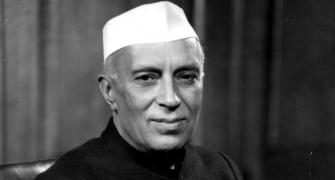'Sweetheart' and 'darling' have been Sheila Dikshit's favourite words for decades -- they go well with her trademark warm, grandmotherly smile. And now, the capital has reciprocated. Dikshit has become the 'darling of Delhi'.
On December 8, she became the only chief minister of Delhi to enter into a third successive term. In the 123-year history of the Congress, she is the third chief minister to have this record after Vasantrao Naik of Maharashtra (1963-75) and Mohan Lal Sukhadia of Rajasthan (1954-71).
Theories about anti-incumbency went for a toss when the Congress, led by Dikshit, won 42 out of 69 seats in the Assembly elections. Throughout the campaign, Dikshit remained the face of Congress. Even posters of Sonia and Rahul Gandhi took a backseat as lamp posts, bus stops, hoardings, glow-signboards and placards had Dikshit as the Congress cover girl.
Although the Congress wrested Rajasthan, geographically the largest state of the country, from the Bharatiya Janata Party, the Congress leadership is happiest about the victory in Delhi. "Winning Delhi is like winning India," says All India Congress Committee Media Cell Chairperson M Veerappa Moily.
Dikshit was born in a non-political family in Punjab's Kapurthala district on March 31, 1938. She was the eldest of three daughters and received her primary education at Delhi's Convent of Jesus and Mary School. After her graduation from Miranda House, she got her post-graduate degree in history from Delhi University.
But her lessons in politics came after her marriage with IAS officer Vinod Dikshit, the son of former Union Minister and Governor Uma Shankar Dikshit. Her acumen in administrative and legislative matters helped her get involved in politics after the 1969 split in the Congress party.
As Indira Gandhi was left with just a handful of trusted lieutenants, she started depending more on this group that included Uma Shankar Dikshit. As her father-in-law's responsibilities and workload in the new party increased, Dikshit started assisting him.
It was during this time that Indira Gandhi noticed her administrative skills. Gandhi's nomination of Dikshit as a member of the Indian delegation to the United Nations Commission on status of women marked her rise in Congress politics.
Elected from the Kannauj Lok Sabha seat of Uttar Pradesh in 1984, she became a minister in Rajiv Gandhi's government after two years. She started as Minister of State for Parliamentary Affairs and later got additional charge in the Prime Minister's Office.
In her third term as the Delhi chief minister, she will oversee the massive programme of change in transport and e-governance that she had begun at the end of the last term, besides making Delhi less helpless when it comes to security.
The road transport system is likely to be modified using public private participation to replace the regime of private buses. She had asked for tenders for the transport pooling system modeled on the Indore transport system, under which a single corporate entity would own one pool of routes and hence would be more accountable. The much criticised BRT corridor work will be continued and expanded.
Her biggest challenge will be the Commonwealth Games which are slated to take place in 2010. The Games had become the catalyst for much of the infrastructure developments that Dikshit's government had undertaken, taking her budget outlay in five years from Rs 12,000 crore to Rs 20,000 crore. With time slipping out of her hands, Dikshit will have to make sure Delhi is ready to host the Games on time.








